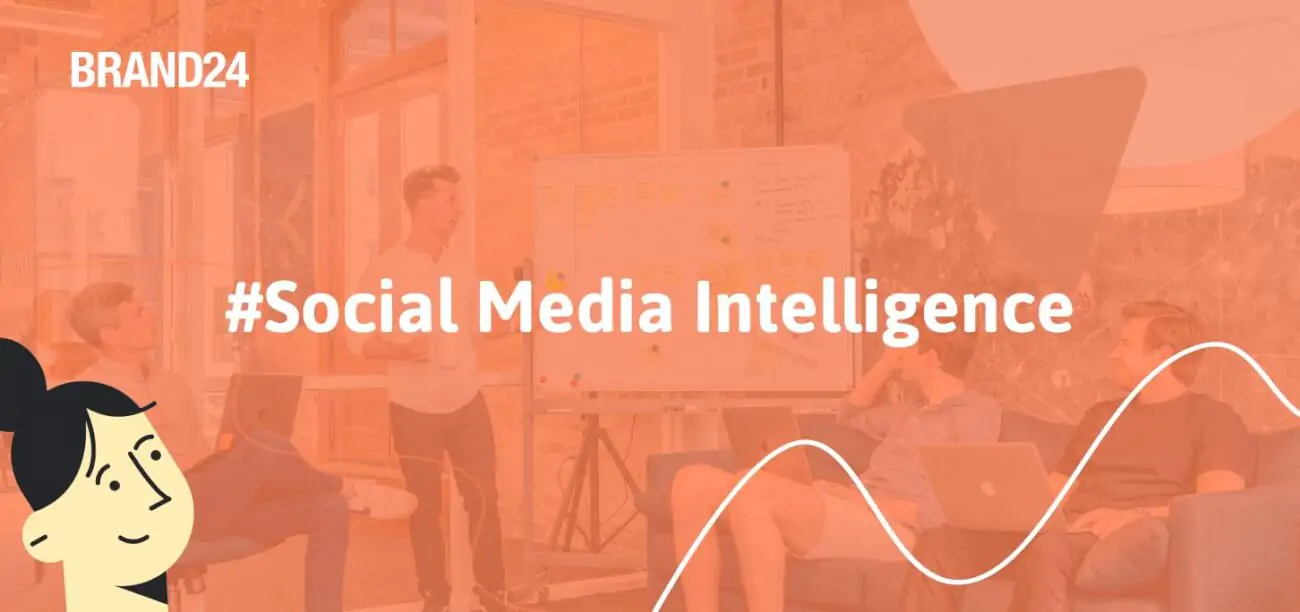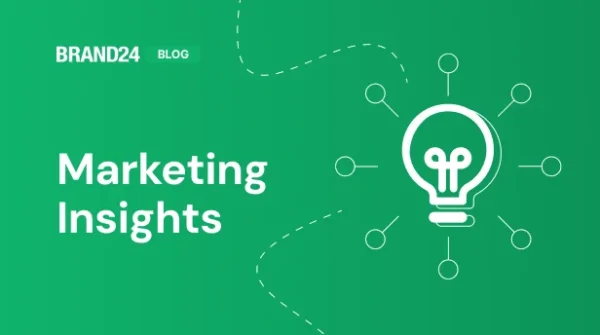9 Game-Changing Social Media Insights I Uncovered in 2024 & 2025
Table of contents
IKEA’s Human Shelter project gained significant attention on social media in December 2024. Engagement peaked on December 15 following the release of Boris Bertram’s documentary The Human Shelter. A single mention on TikTok reached 181,900 people. This underscores the topic’s importance and shows that IKEA effectively uses social media insights to amplify its message and connect with its audience.
How do you dig up this and more social media insights? Let’s dive in!
Social media insights are useful information gathered by tracking and analyzing activity on social media platforms. They go beyond simple numbers, helping you learn more about your audience, their habits, preferences, and how they engage with your brand and content.
Here’s a list of benefits of applying social media insights to your marketing strategy:
- Inform What Works & What Doesn’t: Social media insights reveal which content, strategies, and social media channels are best, helping refine your approach.
- Identify Opportunities & Pain Points: Pinpoint areas for growth, such as untapped audiences or successful content types, and address challenges like low engagement or audience disconnect.
- Drive Business Growth: Use actionable insights to enhance strategies, improve customer experiences, and achieve measurable results.
What are social media insights?
Let’s start from the beginning.
Social media insights are an in-depth understanding of platform specifics and audience behavior on specific social media channels, needs, and preferences.
However, I found it’s common for social media managers to confuse them with social media analytics. Although not visible at first look, the difference between them is huge.
In short, social media analytics collects raw social media data, and insights interpret this data to identify trends and answer “why.”
For example, social media analytics will show a drop in conversions on Instagram; insights reveal that followers’ activity time has changed.
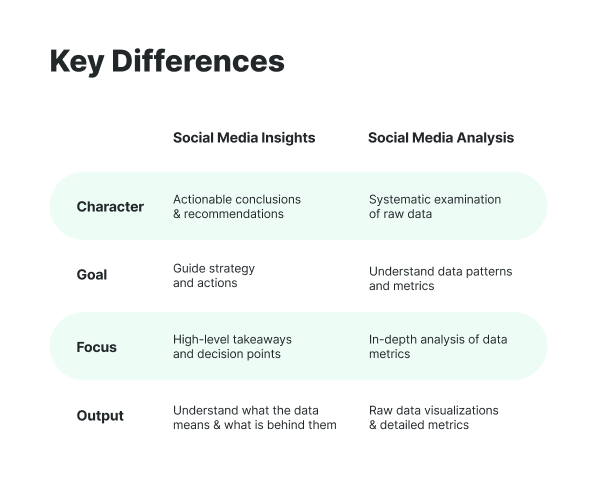
Social media insights tools & social media analytics tools
Generally, the same audience insight tools can be used in both cases.
Whether you focus on analysis or extracting social media insights depends more on your needs and approach than the tool itself.
It’s easy to see the difference now, isn’t it?
Get Your Social Media Insights!
9 key social media insights:
In creating a list of key social media insights for 2025, I wanted to make a practical and easy-to-use list of insights you can quickly apply to your strategy.
That’s why each insight has a “how to translate it into action?” section, so you can effortlessly turn insights into results.
01 Followers’ insights can help you boost your social media reach
Understanding your followers is the secret weapon of social media marketing success.
By analyzing consumer behavior and actions, I’ve uncovered key audience insights that have allowed me to tailor solutions, improve the customer experience, and meet their needs more effectively.
These insights about followers have enabled me to create strategies that resonate with them, increase engagement, and deliver impressive results.
For example, I could identify the types of content that drive the most engagement, discover which platforms my audience prefers, and uncover popular topics that kept them coming back for more.
With this knowledge, I didn’t just drive digital marketing – I built a loyal community.
How do you turn this into action?
To do this, I use social media tools that help me collect data about all my users.
I like to start with native platform tools like Meta Business Suite or Twitter Analytics. These tools offer essential insights, such as audience demographics, age, location, etc. It is a great point to start.
To truly understand my target group, I need more than numbers. For me, it’s essential to hear and see them. Understand their emotions, motivations, preferences, and needs.
That’s where social listening tools come into play. Designed to track real-time conversations, tools like Brand24 can quickly reveal what audiences are saying and feeling about brands.
By monitoring social media conversations, I can uncover actionable insights into social media trends and audience behavior to connect with the audience on a deeper level.
Here, you can see all the IKEA mentions collected by Brand24.
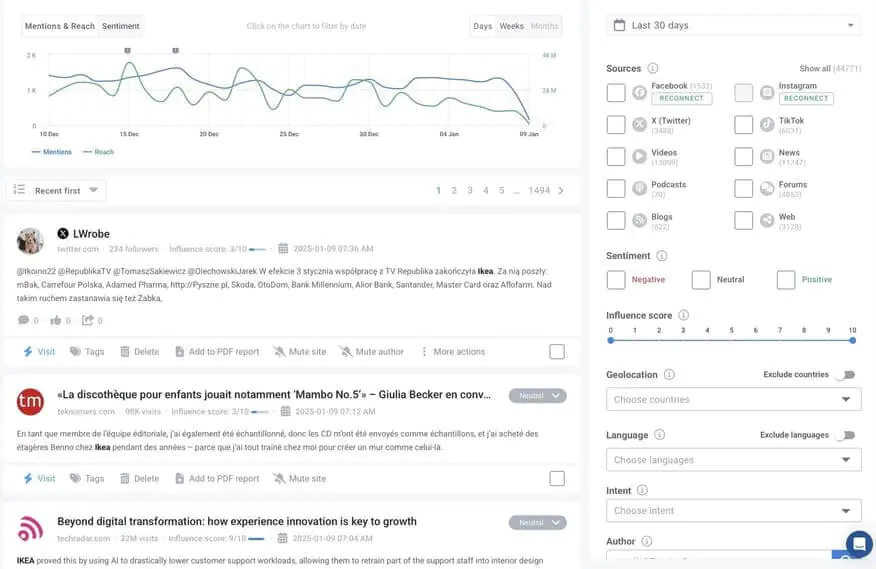
Having all the social mentions in one place shows me what they are talking about, how they feel, and where they are. To speed up searching, you can filter mentions by:
- Sentiment – To quickly identify trends or strong and weak points of social media marketing strategy.
- Language and location – To quickly identify valuable insights into the target audience
- Influence score – To find the most important mentions that can influence other audiences
- Intent—Select goals to gain substantial insights, such as customer satisfaction or brand loyalty.
Then, you can explore themes, emotions, emojis, or hashtags to stay aligned with your audience and connect with their interests and conversations.
Uncover your followers’ insights!
02 Proper posting time can increase content engagement
Social media is about timing.
To truly engage the audience, you must hit the sweet spot when they’re most active on the platform.
For example, if their interactions increase during the evening but you post in the morning. They will miss your content after the entire day.
How to turn it into action?
Analyzing the best hours to post without any tool may be a challenge. Also, searching for “best time to post on social media” will only get me general advice based on all online users – between 9 in the morning and 2 in the afternoon.
But this answer misses the power of social media insights…
Firstly
Each target group can behave differently. I found various preferences among one target group within particular social channels.
Secondly,
Their activity time might differ during the year. Depending on summer sales, holidays, or Christmas time.
That’s why I have leveraged a media monitoring tool where I can monitor audience activity constantly.
The “Hot Hours” tab identifies when IKEA followers are most active.
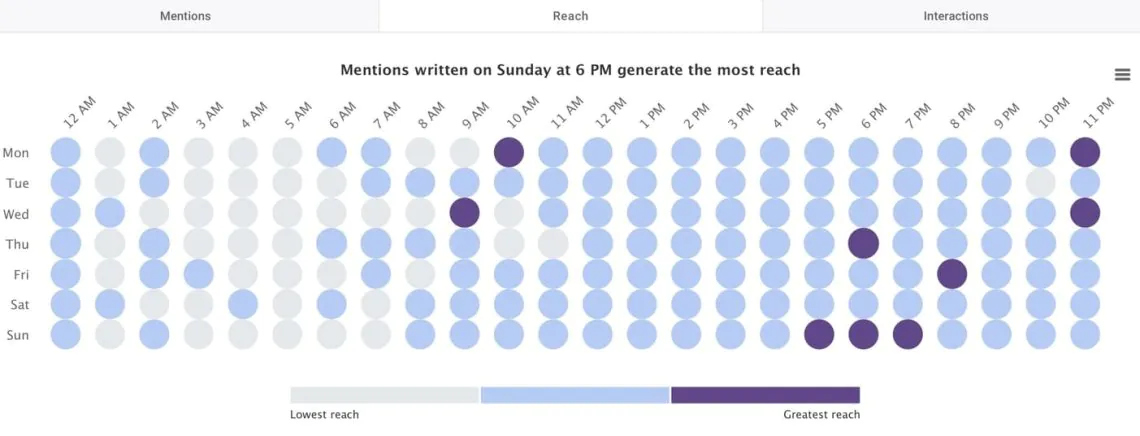
As you see, this general advice doesn’t work for IKEA. Engaging with their audience works best during evenings and weekends.
This is a valuable insight; people look for housing inspiration when they are more relaxed and probably at home.
03 Tracking mentions can save you from a PR crisis
Social media mentions do more than just measure your brand’s popularity—they’re a powerful tool to keep your business thriving.
By tracking mentions, I catch early warning signs of potential brand issues before they become significant challenges.
Using tools focused on sentiment analysis, I uncover social media insights that help keep customers satisfied, identify problems to solve quickly and stay one step ahead of competitors.
How to Turn It Into Action?
Analyze mentions – what are they talking about the company? How do they feel about your service or your content?
Monitor sentiment around the brand – if you notice a sudden spike in negative mentions, react quickly and find out what is causing it.
Track emotions over time to spot early signs of negative reactions, such as anger, fear, or sadness.
Compare customer sentiment and emotions over different periods, which will help you understand whether your actions are improving your brand reputation or the opposite.
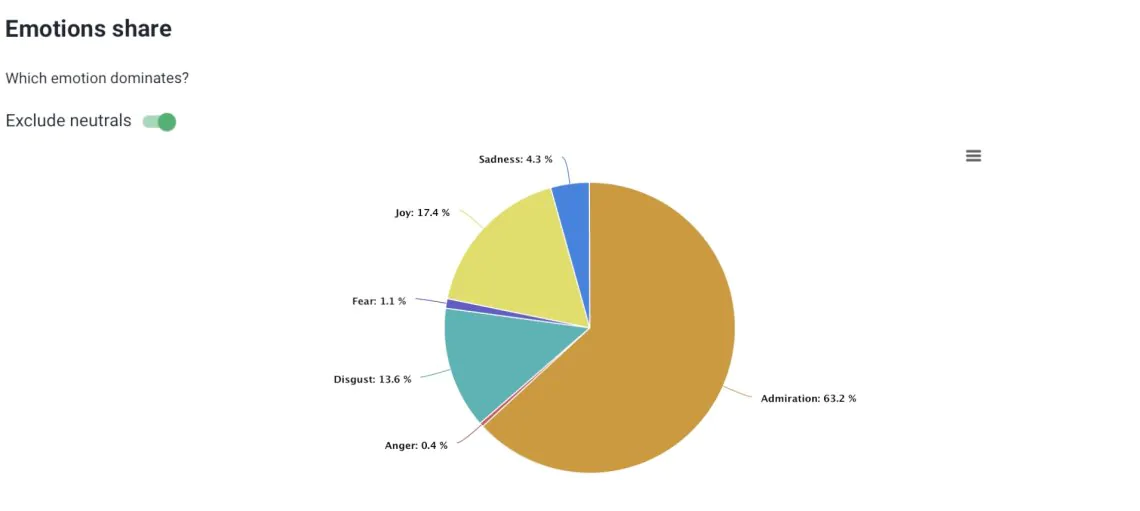
Despite those, to sleep calmly, apply the Storm Alert to get information about any sudden change around your brand.

Define what’s the storm by yourself!
04 Short-form videos can boost your reach quickly
Short videos have become one of the most effective social media content formats, offering the highest return on investment (ROI) compared to other types of content.
These videos aren’t just perfect for delivering quick, engaging, and educational content—they’re also a powerful addition to your advertising strategy.
If you haven’t started using them in your campaigns, now is the time to optimize your social media efforts and take the benefits.
Creativity, brevity, and authenticity are the secrets to social media success. When your videos are short, compelling, and genuine, they create value and keep your audience coming back for more.
How to Turn It Into Action?
Start with social media platforms that use those types of content, like YouTube, Instagram, or TikTok videos.

Create content that aligns with your audience and brand message, remembering that the first three seconds are crucial for capturing attention.
No matter your industry, short videos are a fantastic way to showcase your product, share valuable industry insights, boost brand recognition, and foster deeper connections with your audience.
They’re a versatile tool for building trust and engagement, from highlighting your expertise to sharing fun behind-the-scenes moments.
Experiment with social media trends, formats, and features like sound effects, music, or subtitles.
Before publishing a short video, I ask myself:
- What is the benefit to the audience?
- Is it helpful? Does it provide interesting information?
- Is the content valuable and useful?
- Is my content authentic and consistent with my brand?
- Is the content tailored to the platform?
- Does it grab attention in the first 3 seconds?
If the answer to all the questions is yes, I know that the content will be attractive to the audience, and thus its reach will be greater.
05 Engaging with the audience will increase page views
No one likes to feel ignored, right?
That’s why sharing valuable and engaging content on social media is essential, as it shows your audience that their voices matter.
It’s all about building a deeper connection with your audience—acknowledging their comments, responding to their feedback, and engaging with their ideas.
When your audience feels noticed and appreciated, they’re more likely to engage with your content.
Higher engagement means the algorithm will work in your favor, promoting enhanced engagement and experimentation to an even wider audience. It’s a win-win for both your brand and your community!

How to turn it into action?
- Track mentions and notifications — Stay active by reacting and commenting whether it’s a simple emoji or a personalized message, your response matters!
- Show genuine emotion — Let your audience feel that their feedback resonates with you.
- Focus on the most influential mentions — Prioritize these, as they can shape public opinion about your social media reputation.
- Be consistent — Engagement is like any relationship; disappearing suddenly can harm the connection you’ve built.
- Speak your audience’s language — Use a tone that resonates with them. Personalize your messages, use their name, and sprinkle in popular emojis or hashtags to add personality and highlight your message’s vibe.
- Keep it authentic — Everyone notices when responses feel copy-pasted, which doesn’t leave a good impression. Be genuine.
- Respond quickly — A timely reply carries much more impact. Waiting weeks to respond might miss the moment entirely.
The key is to remember that behind every comment is a real person waiting for your response!
Find your audience and build a community
around your brand!
06 Hashtags still work in 2024
Hashtags haven’t died. They’re still a fantastic tool for boosting brand visibility!

I’ve found that it’s helpful to use hashtags to categorize content to make it easier for my audience to find out what they are looking for. Also, to track hashtags and monitor their performance, for example, during a marketing campaign.
The best part is that many companies have stopped using them, which makes it an excellent opportunity for you to stand out and make it easier for potential clients to find you!
How to turn it into action?
Start by tracking hashtags to optimize your actions. Use them for social media campaigns, your brand name or slogan, events, and relevant happenings in your industry.
Use the right hashtags that are popular around your audience. For this, I checked the “Hashtag analysis” tab in Brand24.
Look, here’s a list of the most common hashtags around IKEA.
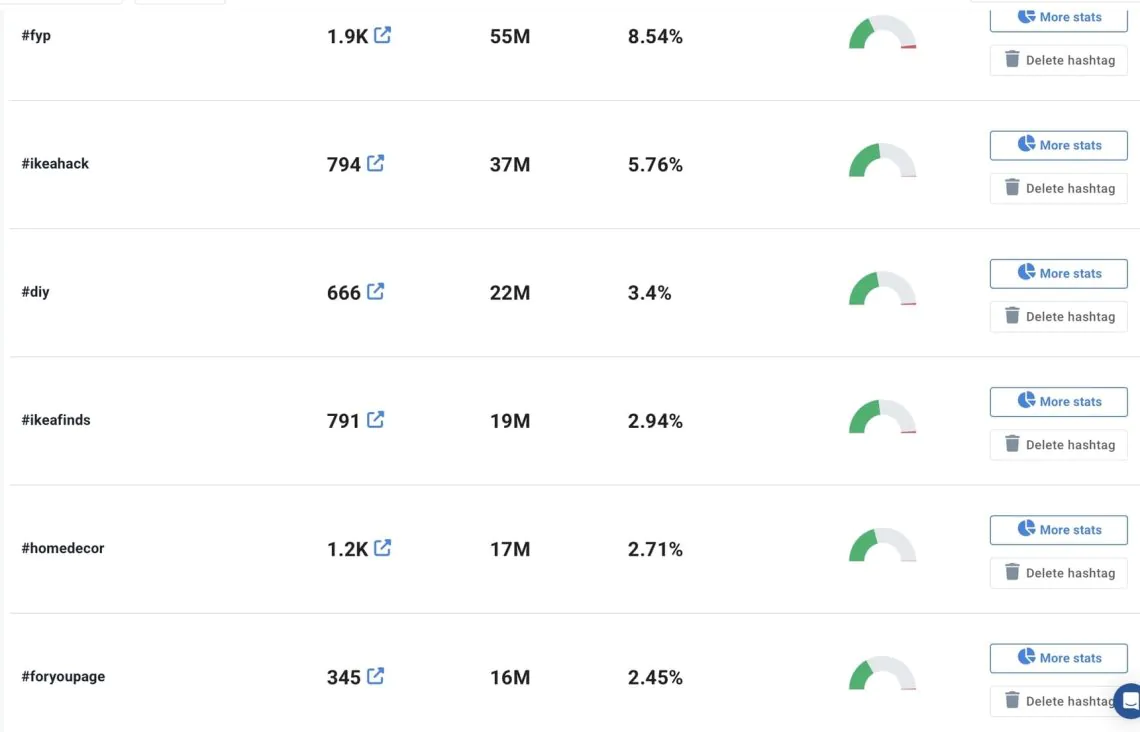
Check your hashtags right now!
07 The greater the share of voice, the better
The more people talk about your brand, the more influence you have in the industry conversation.
Share of Voice (SOV) is a key way to see how visible your brand is compared to your competitors.
For me, it’s the best way to check how much space a brand has in a specific marketing channel – giving a complete picture of its position in the market.
The higher the SOV, the greater the brand’s authority and influence in its niche, signaling strong recognition and presence. SOV works across major social media platforms.
If you don’t monitor SOV regularly, you miss valuable insights about your brand’s market position and competitive edge.
How to turn it into action?
If your Share of Voice (SOV) is lower than your competitors. In that case, your brand is less visible and less engaged in the market, which may suggest weaker brand authority or a less effective social media strategy.
Here, you can see that Walmart has a higher share of voice than IKEA in the USA market.
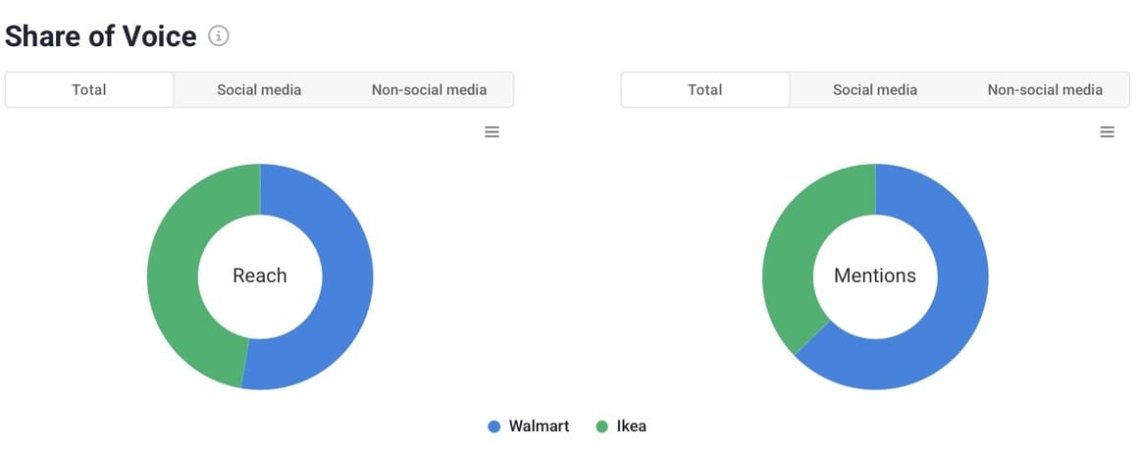
- Audit channels: Identify which channels are underperforming by analyzing engagement rates, impressions, and content reach.
- Optimize Content: Create more targeted, relevant, and engaging content that aligns with your audience’s preferences.
- Analyze Competitors: Study what’s working for your competitors—content type, posting schedule, or engagement strategies—and adapt them to fit your brand.
- Leverage Influencers: Collaborate with influencers or key voices in your industry to amplify your brand’s reach.
- Increase Investment: Allocate more resources to SEO, content marketing, or paid campaigns to boost social visibility in key channels.
However, to maintain a high share of voice, you must be regular in your activities and monitor them regularly.
08 Positive sentiment is important
Positive sentiment is essential to social media performance today.
If customers share positive experiences with your brand, they are satisfied and have a strong emotional connection—in the end, they want to tell you about it!
I have found monitoring positive customer sentiment extremely powerful. It allows me to identify what’s working in my social media efforts and what needs improvement or drop so that I don’t burn resources.
How to turn it into action?
I like to use Brand24 to track this indicator. With this tool, I can:
- Track how sentiment changes over time to stay on top of the latest industry trends
- Use the relevance of topics in communications
- Compare results over time to understand the effectiveness of marketing campaigns
- Prioritize activities across platforms

As you can see, 24% of the 13M mentions are negative, focusing on customer in-store experiences. This presents a valuable opportunity for IKEA to take action.
How about your sentiment?
09 Influencer collaborations are the easiest way to reach a new audience
Influencer marketing is more than just “another collaboration.”
People crave authenticity and meaningful relationships in today’s fast-paced, technology-driven world. Influencers offer genuine human interaction and effective social proof that resonates with audiences.
Provide authentic experiences and trusted recommendations, increasing their credibility and building lasting trust. In a competitive market, such authenticity sets a brand apart and keeps it in the spotlight.
How to turn it into action?
To do it well, you need to choose influencers smartly.
A vegan influencer might not be the best fit for promoting a new beef burger joint in town, even if their social media content mainly concerns reviewing restaurants.
Identify influencers who talk about your brand and align with your values and mission.
Here’s a list of influencers who have already engaged with IKEA by mentioning it, which means that their collaboration could be more authentic and natural.

What is the best way to get social media insights?
To speed up this process, it’s worth tapping into the potential of AI-powered tools to gather and mine social media insights from vast amounts of social media data in seconds.
While these tools are still evolving and can sometimes make minor mistakes, the truth is that they can significantly enhance your effectiveness – just remember to double-check.
They can quickly identify:
- Social media trends
- The mood of the audience
- Popular topics
In addition, they can analyze:
- Social media performance
- Competitors
- Customer behavior
For this, one of my favorite daily tools is the AI Insights tab, where I can quickly generate a social media insights report.
In just 60 seconds, it provides me with the most essential information about what’s happening around the brand, keeping me informed and ready to take action.

However, if I need a quick answer to a specific question, I use Brand Assistant. It works similarly to ChatGPT – it’s conversational.
For example, I asked the Brand Assistant, “What are the current trends and challenges in the market for IKEA?” it provided detailed information about the most influential mention, familiar topics, and buzz around the Christmas collection and meatballs.
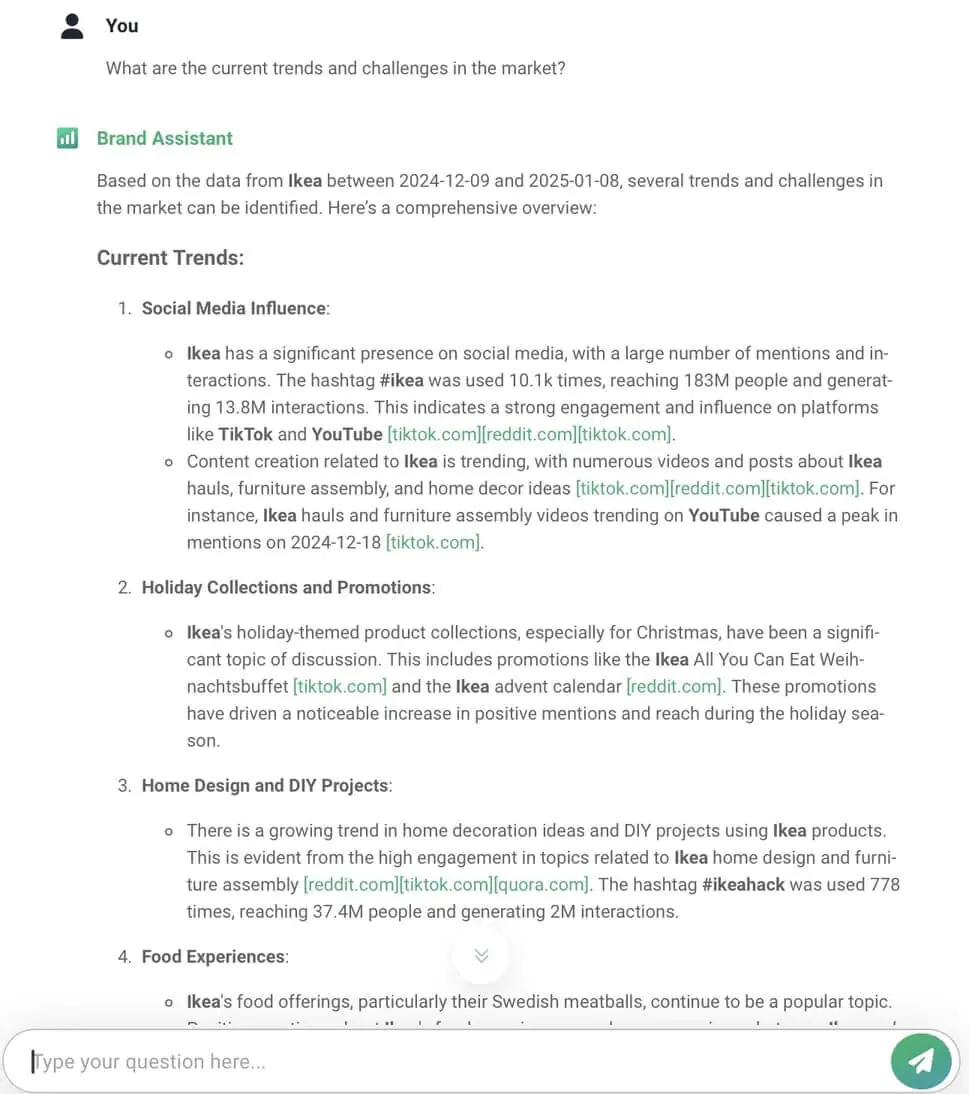
Additionally, it can provide recommendations or summarize competitors’ activities, which is incredibly helpful for extracting actionable social media insights.
Ask a question of Brand Assistant!
Key takeaways
Social media insights go beyond mere numbers – they represent real people.
Unlike social media analytics, it’s not just about collecting numbers – it’s about understanding what those numbers mean.
To connect with your audience and understand their activity on digital channels, you need a tool that allows you to see and listen to them.
Rather than write an essay on why social listening is essential to gain actionable social media insights (although I could!).
Here’s a short list of the most significant benefits that will show you why social listening tools, like Brand24, are one of my favorites:
- Real-time audience information: Stay informed by understanding what your audience is talking about – whether it’s about your brand, industry, or popular topics.
- Better engagement strategies: Identify what resonates with your audience so you can create content and campaigns that hit the mark every time.
- Reputation management: Detect and resolve any negative comments or crises before they get out of hand, keeping your brand image intact.
- Social media insights reporting: Generate comprehensive AI Insights reports that summarize key data and trends, making it easy to share insights with your team and adapt strategies effectively.
You already have the theories – now it’s time to see them in action. Start your Brand24 trial period today and dive into powerful social media knowledge!
Related articles

![A Complete Guide to AI Social Media Analysis [2025]](https://brand24.com/blog/app/uploads/2020/03/750x300_x2-1.png)

![Top 11 Social Media Audit Tools to Detect Valuable Insights [2025]](https://brand24.com/blog/app/uploads/2023/07/Social-media-audit-tools-cover.jpg)

